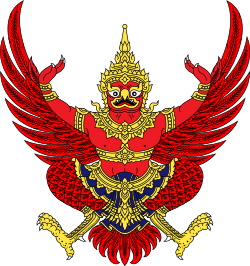Rattanakosinské království
| Rattanakosinské království Siamské království อาณาจักรรัตนโกสินทร์ Anachak Rattanakosin ราชอาณาจักรสยาม Ratcha-anachak Sayam
| |||||||||||||||||||||||||||||||
| Hymna จอมราชจงเจริญ, Chom Rat Chong Charoen (1852–1871) บุหลันลอยเลื่อน, Bulan Loi Luean (1871–1888) สรรเสริญพระบารมี, Sansoen Phra Barami (1888–1932) | |||||||||||||||||||||||||||||||
| Motto สพฺเพสํ สงฺฆภูตานํ สามคฺคี วุฑฺฒิ สาธิกา („Jednota sjednocených přináší úspěch a prosperitu“) | |||||||||||||||||||||||||||||||
Geografie
| |||||||||||||||||||||||||||||||
| Obyvatelstvo | |||||||||||||||||||||||||||||||
centrální thajština (úřední), severní thajština, jižní thajština, laoština, khmerština, šanština, malajština, čínské jazyky | |||||||||||||||||||||||||||||||
| Státní útvar | |||||||||||||||||||||||||||||||
| Státní útvary a území | |||||||||||||||||||||||||||||||
| |||||||||||||||||||||||||||||||
Rattanakosinské království (thajsky อาณาจักรรัตนโกสินทร์, přepis RTGS: Anachak Rattanakosin) bylo siamské, resp. thajské království existující v letech 1782–1932, které bylo předchůdcem moderního thajského státu. V diplomatických stycích a smlouvách bylo do roku 1939 známo jako Siam (thajsky สยาม) a Siamské království (thajsky ราชอาณาจักรสยาม, RTGS: Ratcha-anachak Sayam).
Historie

V roce 1767 se generál Taksin nechal korunovat siamským králem. Po jeho úspěšné vzpouře proti Barmáncům však bylo hlavní město natolik zdevastované, že své sídlo přesunul do Thonburi (dnes součást Bangkoku). Taksin byl roku 1782 svými dvořany prohlášen za nepříčetného a zabit. Vlády se ujal vojenský velitel Phra Phutthayotfa Chulalok a nastoupil na trůn jakožto Ráma I. Nová dynastie Čakrí (jež sedí na thajském trůnu dodnes) přesunula hlavní město na opačný břeh řeky Čaophraja, do Bangkoku. Pokračovala v mocenské expanzi, zahájené už Taksinem, a vynutila si hegemonii na celém území mezi Barmou a Vietnamem. Koloniální pronikání Británie a Francie do regionu však představovalo vážnou hrozbu také pro Siam. Králové Mongkut (Ráma IV., 1851–1868) a Čulalongkorn (Ráma V., 1868–1910) reagovali vstřícnou diplomacií, územními ústupky a reformami, které měly jednak zvýšit prestiž Siamu v očích mocností, jednak upevnit centralizovanou státní moc na územích, která byla dosud vůči Bangkoku ve volném vazalském poměru. Tak vznikl moderní thajský stát v nynějších hranicích.
Státní symbolika
- znak:
- vlajka:
Odkazy
Reference
V tomto článku byl použit překlad textu z článku Rattanakosin Kingdom (1782–1932) na anglické Wikipedii.
Média použitá na této stránce
The national flag of Kingdom of Thailand; there are total of 3 colours:
- Red represents the blood spilt to protect Thailand’s independence and often more simply described as representing the nation.
- White represents the religion of Buddhism, the predominant religion of the nation
- Blue represents the monarchy of the nation, which is recognised as the centre of Thai hearts.
No official flag.
Autor: Sodacan, Licence: CC BY-SA 4.0
Flag of the Kingdom of Vientiane (1707 - 1828)
A red flag with a white Sudarshana Chakra of Vishnu which is used as a symbol of the Chakri Dynasty today. The Chakra in this image was adapted from Naval Jack Thailand.svg.
Please note that there was no specification design for this flag.Autor: Sodacan, Licence: CC BY-SA 4.0
Flag of the Kingdom of Champasak (ຈຳປາສັກ), used since 1713 to 1947.
State flag of siam. This flag was being used between 1916-1917 and also used as Siamese naval ensign during 1887-1910. It features dressed white elephant on red background, facing a flagpole.
Flag of the Patani Kingdom/Sultanate of Pattani until 1816.
Crop of portrait of King Buddha Yodfa Chulaloke (Rama I), which is displayed in the Chakri Mahaprasad Hall at the Grand Palace, Bangkok. Portrait created during the reign of King Chulalongkorn, meaning it was created no later than 1910 (identity of the creator is unknown to the uploader). Image taken from web page of the Public Relations Department, Region 3,
Flag of Thailand from Ayutthaya period. Use as civil ensign until 1855, naval ensign until 1872. It is a red plain flag.
"The White Elephant Flag" Thai national flag from 1855 to 1916, 31 December. It has a white elephant (based on Image:Naval Ensign of Thailand.svg) on red plain rectangular flag.
ลัญจกรเจ้าผู้ครองนครเชียงใหม่
Autor: Sodacan, Licence: CC BY-SA 3.0
Royal Coat of Arms of the Kingdom of Siam 1873 to 1910. Description from Emblem of Thailand.
- Shield depicting the three-headed elephant (Erawan) of Siam, the White Elephant (Lan Xang) of Laos and the Krises of Malaya.
- Crowned by the Great Crown of Victory (rays of light from behind), Behind the shield are the crossed Sword of Victory (left), Royal Staff (right), Royal Fan (right) and Flywisk (left). The shield is surrounded on two sides by two seven-tiered Royal Umbrellas. On the compartments are two Royal Slippers. All, composing the six Royal Regalia of Siam.
- the Mantle is the cloak (with pink ribbons) of the Order of the Chula Chom Klao, the order around the shield is the Order of the Nine Gems with Chula Chomklao chain and pendant (with a portrait of King Rama V on it).
- Motto on green and red ribbon reads: "สพฺเพสํ สงฺฆภูตานํ สามคฺคี วุฑฺฒิ สาธิกา" (Pali written in Thai alphabet) ("Sabbesam Sanghabhutānam Sāmaggī Vuḍḍhi Sādhiga") or "Unity brings happiness".
- Supported by a Kojasiha; a lion with elephant trunk (dexter), and a Rajasiha; a lion (sinister), representing Kalahom and Mahathai, respectively.
National Emblem of Thailand, depicting a dancing Garuda with outstretched wings. The Garuda symbolizes the government and people of Thailand, as Lord Vishnu symbolizes King of Thailand.
State and Naval Ensign of Siam (now Thailand) in 1817-1855. It's a red rectangular flag with a white elephant in the Sudarshana chakra. Adopted by King Rama II (Buddha Loetla Naphalai) of Siam. This image is an adaptation of Image:Flag of Thailand (1782).svg and Image:Flag of Thailand 1855.svg.
Please note that there is/was no specification design for this flag.Autor: Sodacan, Licence: CC BY-SA 4.0
Flag of the Kingdom of Luang Phrabang (1707 - 1893)
Autor: Milenioscuro, Licence: CC BY-SA 4.0
Mapa del Reino de Rattanakosin






























